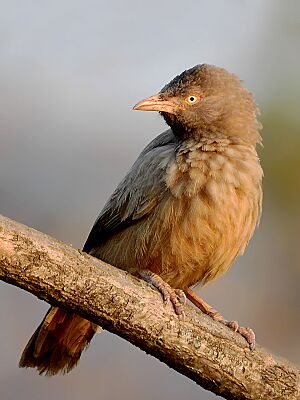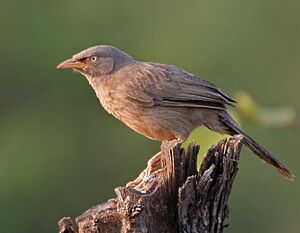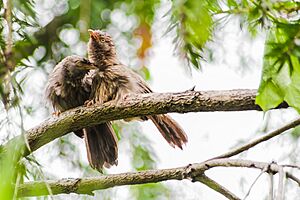Jungle babbler facts for kids
Quick facts for kids Jungle Babbler |
|
|---|---|
 |
|
| Turdoides striata somervillei from Maharashtra | |
| Conservation status | |
| Scientific classification | |
 |
|
| Synonyms | |
|
Turdoides striatus |
The jungle babbler (Argya striata) is a bird found in the Indian subcontinent. These birds are very social and live in small groups. You can often see them in groups of six to ten birds. Because of this, people in Northern India sometimes call them the "Seven Sisters". In other languages, they are known as "seven brothers."
Jungle babblers are common birds. You can find them in gardens in big cities and also in forests. They are resident birds, meaning they do not migrate to other places. The orange-billed babbler from Sri Lanka used to be thought of as a type of jungle babbler. But now, scientists consider it a separate species.
Contents
About the Jungle Babbler
The jungle babbler was first described by a French zoologist named Charles Dumont de Sainte Croix in 1823. He saw them in Bengal. These birds were once placed in a group called Turdoides. However, after new studies in 2018, they were moved to a different group called Argya.
There are several types of jungle babblers, called subspecies. They live in different areas and have slightly different feather colors.
- A. s. striata lives in northern India, near the Himalayan foothills, and in places like Bhutan and Assam.
- A. s. sindiana is a paler type found in the deserts of Pakistan and Rajasthan.
- A. s. somervillei lives in the northern Western Ghats in India.
- A. s. malabarica is found in the southern Western Ghats.
- A. s. orientalis lives in other parts of India, east of the Western Ghats.
What Jungle Babblers Look Like
Jungle babblers live in forests and cultivated areas. Like most babblers, they do not fly long distances. They have short, rounded wings and do not fly very strongly. Male and female jungle babblers look the same. They are dull brownish-grey with a yellow bill. This can make them look similar to the yellow-billed babblers found in India and Sri Lanka.
Their upper feathers are usually a bit darker. They also have some spots on their throat and chest. The type of jungle babbler found in Maharashtra (T. s. somervillei) has a reddish-brown tail and dark wing feathers. You can tell a jungle babbler apart from a white-headed babbler because the jungle babbler has a dark area between its bill and eye. Also, it does not have a bright, light-colored head. The sounds they make are also very different. Jungle babblers make harsh, nasal calls. White-headed babblers have high-pitched calls. Another bird often seen in cities is the large grey babbler. But this bird has a long tail with white feathers on the outside.
Jungle babblers live in groups of seven to ten or more birds. They are very noisy birds! You can usually hear a flock from far away. They make loud mewing calls, chattering, squeaking, and chirping sounds.
Behavior and Life Cycle
These birds are very social. They sometimes join other bird species to look for food together. They mostly eat insects. But they also enjoy grains, nectar from flowers, and berries. Each group of babblers has its own territory. They will protect their area from other groups, but sometimes they let neighbors stay. These birds can live for a long time for their size. Some have lived up to 16.5 years when cared for by humans.
When a group is looking for food, some birds will sit high up. They act as lookouts to warn the others of danger. They are known to gather together and chase away predators like snakes.
Young jungle babblers have dark eyes. As they get older, their eyes turn a pale creamy color. This happens because muscle fibers grow in their eyes, making the dark color underneath invisible.
Jungle babblers can breed all year round. In northern India, they breed most often between March and April, and again from July to September. Birds are ready to have their own young after they are three years old. They build their nests halfway up in a tree. The nests are hidden well in thick leaves. A female usually lays three or four eggs, but sometimes up to seven. The eggs are a deep greenish-blue color. In northern India, birds that breed from July to September sometimes have their nests used by other birds. These "parasite" birds, like the pied crested cuckoo or the common hawk-cuckoo, lay their eggs in the babbler's nest. Other birds in the group, called "helpers," also help the parents feed the young. Most young birds survive after they leave the nest.
Young birds leave the nest, and female birds often leave their family group after about two years. Birds in a group often groom each other. They also play by chasing and having mock fights. If they feel threatened by predators, they sometimes pretend to be dead.
Jungle Babblers in Culture
These birds are very common near towns and cities, especially in northern India. People know them well for moving in groups. This is why they are called "Sat Bhai," which means "seven brethren" in Hindi. The English in India translated this to "Seven Sisters." People visiting India often noticed these noisy and active birds. Frank Finn, a writer, shared a story from the time when India was ruled by the British:
Some years back, a new Viceroy was being shown the wonders of his temporary kingdom, and among these the Taj at Agra held, of course, an important place. Arrived before the glorious monument of Eastern love and pride, the artless Aide-de-Camp was mute; the gilded staff were still as Kipling says, in anxious expectation of the comment of His Excellency. But this, alas when it came was merely the remark: "What are those funny little birds?" The shock must have been the greater for the fact that the mean fowls thus honoured were it seems, of that singularly disreputable species which is commonly known in India as the "Seven Sisters" or "Seven Brothers," or by the Hindustani equivalent of sat-bhai.
An Indian storyteller named Saratcandra Mitra wrote about a belief among the Lushai-Kuki people. They believed that during a solar eclipse, humans could turn into jungle babblers.
Images for kids









